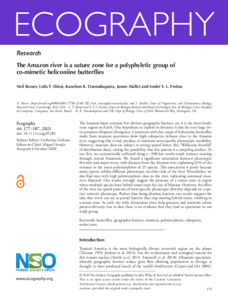Rosser, Neil;
Shirai, Leila T;
Dasmahapatra, Kanchon K;
Mallet, James;
Freitas, Andre VL;
(2020)
The Amazon river is a suture zone for a polyphyletic group of co-mimetic heliconiine butterflies.
Ecography
, 44
(2)
pp. 177-187.
10.1111/ecog.05282.

![[thumbnail of rosser et al. 2020 Amazon suture zone.pdf]](https://discovery.ucl.ac.uk/10173724/1.hassmallThumbnailVersion/rosser%20et%20al.%202020%20Amazon%20suture%20zone.pdf)  Preview |
PDF
rosser et al. 2020 Amazon suture zone.pdf - Published Version Download (4MB) | Preview |
Abstract
The Amazon basin contains few obvious geographic barriers, yet it is the most biodiverse region on Earth. One hypothesis to explain its diversity is that the very large rivers promote allopatric divergence. Consistent with this, maps of heliconiine butterflies made from museum specimens show high subspecies richness close to the Amazon river, suggesting that it may produce or maintain intra-specific phenotypic variability. However, museum data are subject to strong spatial biases (the ‘Wallacean shortfall' of distribution data), raising the possibility that this pattern is a sampling artefact. To test this, we systematically collected along a ~900 km north–south transect running through central Amazonia. We found a significant association between phenotypic diversity and major rivers, with distance from the Amazon river explaining 61% of the variance in the mean polymorphism of 25 species. This association is partly because many species exhibit different phenotypes on either side of the river. Nonetheless, we also find sites with high polymorphism close to the river, indicating continual cross-river dispersal. Our results strongly suggest the presence of a suture zone (a region where multiple species have hybrid zones) near the city of Manaus. However, the effect of the river on spatial patterns of intra-specific phenotypic diversity depends on a species' mimetic phenotype. Rather than being absolute barriers, our results support the idea that rivers can act as partial barriers that trap moving hybrid zones, resulting in a suture zone. As such, the wide Amazonian rivers help generate and maintain colour pattern diversity, but to date there is no evidence that they lead to speciation in our study group.
| Type: | Article |
|---|---|
| Title: | The Amazon river is a suture zone for a polyphyletic group of co-mimetic heliconiine butterflies |
| Open access status: | An open access version is available from UCL Discovery |
| DOI: | 10.1111/ecog.05282 |
| Language: | English |
| Additional information: | This work is licensed under a Creative Commons Attribution 4.0 International License. The images or other third-party material in this article are included in the Creative Commons license, unless indicated otherwise in the credit line; if the material is not included under the Creative Commons license, users will need to obtain permission from the license holder to reproduce the material. To view a copy of this license, visit http://creativecommons.org/licenses/by/4.0/ |
| Keywords: | Science & Technology, Life Sciences & Biomedicine, Biodiversity Conservation, Ecology, Biodiversity & Conservation, Environmental Sciences & Ecology, butterflies, geographic barriers, mimicry, polymorphism, subspecies, suture zone, GLOBAL PATTERNS, HYBRID ZONES, SPECIATION, DIVERSITY, SELECTION, MOVEMENT, BIRDS, CONSERVATION, HYPOTHESIS, DRIVERS |
| UCL classification: | UCL UCL > Provost and Vice Provost Offices > School of Life and Medical Sciences UCL > Provost and Vice Provost Offices > School of Life and Medical Sciences > Faculty of Life Sciences UCL > Provost and Vice Provost Offices > School of Life and Medical Sciences > Faculty of Life Sciences > Div of Biosciences UCL > Provost and Vice Provost Offices > School of Life and Medical Sciences > Faculty of Life Sciences > Div of Biosciences > Genetics, Evolution and Environment |
| URI: | https://discovery.ucl.ac.uk/id/eprint/10173724 |
Archive Staff Only
 |
View Item |


